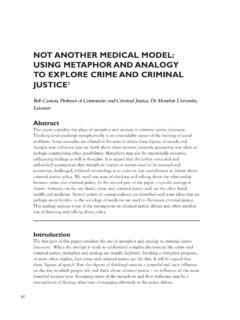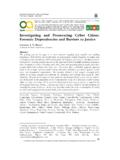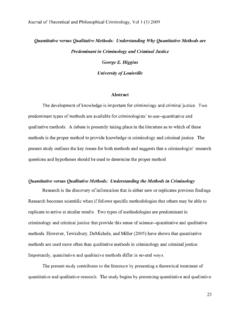Transcription of CRIMINOLOGY: AN OVERVIEW
1 UNESCO EOLSSSAMPLE CHAPTERSLAW - criminology : An OVERVIEW - Robert Agnew Encyclopedia of Life Support Systems (EOLSS) criminology : AN OVERVIEW Robert Agnew Department of Sociology, Emory University, Atlanta, Georgia, United States 30322 Keywords: Crime, criminology , causes of crime, criminal justice, crime control, strain, social control, self control, social learning, labeling, routine activities perspective, rational choice theory, social disorganization, critical theories, deterrence, incapacitation, rehabilitation, prevention, police, courts, corrections, restorative justice, criminal law, victim, victimization, offender Contents 1.
2 A Historic OVERVIEW of criminology 2. The Origin of Criminal Laws 3. The Extent of and Trends in Crime 4. The Types of Criminal Offenders 5. The Socio-demographic Characteristics of Criminal Offenders 6. The Characteristics of the Major Types of Crime 7. Research on Crime Victims 8. Causes of Crime Bio-psychological Theories Strain Theory Social Learning Theory Control Theory Labeling Theory Situational Theories Explaining Community Differences in Crime Explaining Gender and Other Socio-Demographic Differences in Crime Explaining Crime over the Life Course Critical Theories Explaining Societal Differences in Crime Developing an Integrated Theory of Crime 9.
3 Controlling Crime The Police The Courts Corrections The Strategies of Deterrence and Incapacitation The Strategies of Rehabilitation and Prevention 10. Conclusion Glossary Bibliography Biographical Sketch Summary criminology is a broad and diverse discipline. Criminologists examine a range of topics, with a focus on the characteristics of offenders and the crimes they commit; the causes UNESCO EOLSSSAMPLE CHAPTERSLAW - criminology : An OVERVIEW - Robert Agnew Encyclopedia of Life Support Systems (EOLSS) of crime; the efforts of the police, courts, and correctional agencies to control crime; and strategies for more effectively controlling crime.
4 No one perspective dominates the discipline. A large number of theories are used to explain crime, with there being a major divide between mainstream theories, which dominate criminological research, and critical theories. Mainstream theories focus on legally-defined crimes and explain such crimes largely in terms of individual traits and features of the immediate social environment, particularly the family, school, peer, work, and neighborhood environments. Critical theories employ broader definitions of crime, devote much attention to corporate and state crimes, and explain such crimes in terms of features of the larger social environment, particularly conflict between more and less powerful groups in a society.
5 Likewise, criminologists advocate several strategies for controlling crime, including deterrence (increasing the fear of crime through certain and severe sanctions), incapacitation (incarcerating offenders so they cannot commit crimes on the street), and rehabilitation and prevention (addressing the root causes of crime among offenders and potential offenders). This chapter provides an OVERVIEW of the major research and theories in criminology , focusing on the causes and control of crime. Many of the research examples are taken from the United States, the site of most crime research at present, but criminology is quite prominent in many other developed nations and is growing in many developing nations (Tonry and Doob 2004; Tonry and Farrington 2005).
6 1. A Historical OVERVIEW of criminology The first modern explanation of crime is known as classical theory (Bernard et al. 2009; Cullen and Agnew 2011). Classical theory was developed in reaction to the corrupt, arbitrary, and harsh systems of criminal justice that existed in Europe during the 1700s. The laws were often vague; bribery of judges was common; punishments for the same crime varied widely; and punishments were sometimes quite harsh, involving torture and death. Classical theorists wanted to replace this system with one that was more effective and just. They argued that people are rational beings who pursue their own interests, attempting to maximize their pleasure and minimize their pain.
7 People choose to engage in crime when they believe that it will bring more pleasure than pain, As such, the best way to control crime is to ensure that the pain of punishment outweighs the pleasure of crime, In particular, individuals will be deterred from crime if punishments are swift, certain, and appropriately severe. But for this system to work, the laws must be clearly stated and applied equally to all. Further, punishments should not be overly harsh; this is unnecessary and will bred resentment. Classical theory has had an enormous impact on the criminal justice systems of many nations; an impact that is evident today.
8 Such systems are based on the assumption that criminals are rational beings who freely chose to engage in crime, state that the law applies equally to all, and attempt to deter crime through punishment. Classical theory is also the direct inspiration for rational choice theory and the crime control strategy of deterrence, which are discussed below. Classical theory came under attack in the late 1800s, with the attack stimulated in part by Darwin s theory of evolution. Cesare Lombroso and others challenged the idea that criminals are rational beings who freely choose to engage in crime (Bernard et al. 2009; UNESCO EOLSSSAMPLE CHAPTERSLAW - criminology : An OVERVIEW - Robert Agnew Encyclopedia of Life Support Systems (EOLSS) Cullen and Agnew 2011).
9 Rather, they claimed that criminals are not as biologically evolved as other people, and their primitive or savage state leads them to engage in crime. Based on his physical examinations of criminals and non-criminals, Lombroso claimed that criminals could be identified by their gross biological features, such as hairiness, large jaw and cheekbones, and protruding lips. Lombroso s theory and others like it were carefully evaluated in the early-to- mid 1900s, with researchers comparing the physical features of criminals to those of carefully matched samples of non-criminals. None of the gross biological differences described by these theories emerged.
10 This fact, along with concern about the policy implications of these theories ( , selective breeding and sterilization), lead to the decline of biological theories for several decades. The work of Lombroso and others, however, contributed to the rise of the positivistic approach to crime; or the ideas that crime is due to forces beyond the individual s control and that theories of crime should be tested against observations of the larger world. The biological theories of Lombroso and others were replaced with psychological and sociological theories of crime, with sociological theories coming to dominate the field of criminology in the mid 1900s.

















